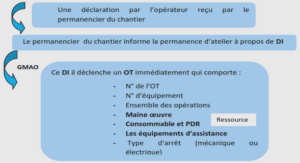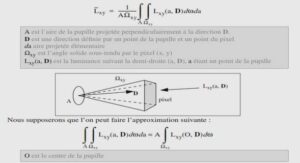On a relation between the turning point locus of a meromorphic connection and its irregularity sheaf
The protagonists and some preleminary results
The Irregularity sheaf The irregularity sheaf has been introduced in [39]. For a detailed treatment of its fundamental properties, one can refer to [40]. As for useful references concerning perverse sheaves, one can mention [21], [41], [11]. In this subsection, X will be a complex manifold, i : Z ֒→ X a closed analytic subvariety of X, IZ its defining ideal, M ∈ Db h (DX) a complex of DX-modules with bounded holonomic cohomology and Char(M) its characteristic cycle. Db c (CX) will denote the derived category of complex of sheaves of C-vector spaces with bounded constructible cohomology and if F ∈ Db c (CX), we will denote by χ(F) : x −→ X k (−1)k rk HkFx the Euler-Poincaré characteristic of F. The local algebraic cohomology functor alg ΓZ(M) := lim−→ HomOX (OX/I k Z ,M) and the localization functor M(∗Z) := lim−→ HomOX (I k Z ,M) 58 The protagonists and some preleminary results give rise to the following distinguished triangle of Db (DX) R alg ΓZ(M) /M /RM(∗Z) +1 / (13.1.1) and one can prove [19] by using Bernstein-Sato polynomial that (13.1.1) lies in Db h (DX). By applying the solution functor S = RHomDX ( , OX), Kashiwara’s constructibility theorem [17] asserts that the distinguished triangle of bounded complex of sheaves i −1S(RM(∗Z)) /i −1S(M) /S(R alg ΓZ(M)) +1 / (13.1.2) lies in Db c (CX). Let us define 14 Irr∗ Z (M) := i −1S(RM(∗Z))[1] (13.1.3) Hence Irr∗ Z (M) is the cone of i −1S(M) /S(R alg ΓZ(M)) (13.1.4) Of fundamental importance about the irregularity sheaf is the following theorem of Mebkhout [39, 2.1.6] Theorem 13.1.5. If Z is an hypersurface, Irr∗ Z (M) is a perverse sheaf on Z. This result will have a crucial role, due to the following general Theorem 13.1.6. Let Z be a smooth complex manifold, and let F be a perverse sheaf on Z with constant Euler-Poincaré characteristic. Then F is a local system concentrated in degree 0. Proof. For the sake of this proof, let us denote by n the dimension of Z. Since F is perverse, it is generically smooth and the constancy of χ(F) reads dim H0Fz − dim H1Fz + · · · + (−1)n dim HnFz = dim H0Fη (13.1.7) for every z ∈ Z, with η denoting the generic point of Z. Let us argue on the dimension of Z. If Z is one dimensional, (13.1.7) simplifies for a given z ∈ Z into the following equality dim H0Fz = dim H1Fz + dim H0Fη Since the perversity condition on F implies that H0F has no section punctually supported at z [21, 10.3.3], we have dim H0Fz ≤ H0Fη, from which we deduce the vanishing of H1F, and 13.1.6 follows from the constructibility of H0F. Let us suppose that n ≥ 2, and take z0 ∈ Z. According to [39, 2.2.1.5], one can choose a neighbourhood U of z0 with the property that for every z ∈ U different from z0, there exists a smooth hypersurface i : Z ′ −→ Z passing through z and such that i −1F is perverse. From the induction hypothesis applied to (Z ′ , i−1F), one gets that H0F|U is a local system away from z0, and for every k ∈ J1, nK, the sheaf HkF|U has support included in {z0}. Since the statement 13.1.7 is local, we will abuse notation by using Z for U in the sequel.
The Euler-Poincaré characteristic of IrrZ(M)
In this subsection, X, Z and M are supposed to be algebraic. As noted in the introduction, Irr∗ Z (M) := Irr∗ Zan(Man) is an analytic invariant. However, we have the following Theorem 13.2.1. The value of χ(Irr∗ Z (M)) at x ∈ Z an only depends on the formalization Mdx := O[X,x ⊗OX,x Mx. Proof. By induction on the number of equation defining Z, the Mayer-Vietoris distinguished triangle [40, 4.2-1] Irr∗ Z1∩Z2 (M) /Irr∗ Z1 (M) ⊕ Irr∗ Z2 (M) /Irr∗ Z1∪Z2 (M) allows us to suppose that Z is an hypersurface. In that case, the localization functor is exact and is simply OX(∗Z)⊗OX . Thus, one can suppose that M = M(∗Z). From the hypercohomology spectral sequence E pq 2 = HpS(HqM) =⇒ Hp+qS(M), we get χ(Irr∗ Z (M)) = X(−1)kχ(Irr∗ Z (HkM)), so it is enough to prove 13.2.1 in the case where M is an actual holonomic DX-module. Let us write Char(M) = Xmα(M)T ∗ Xα,regX, where mα(M) is a positive integer, Xα is a closed irreducible subvariety of X and Xα,reg its regular part. Then the local index theorem [18], [20], [35] asserts that χ(i −1S(Man))(x) = X(−1)dα e(x, Xα)mα(M), 62 The protagonists and some preleminary results where dα denotes the codimension of Xα in X and e(x, Xα) stands for the Euler obstruction defined by Mac-Pherson [32]. This latter invariant is of topological nature and is equal to 0 in case x /∈ Xα. Then, if Xα is a closed irreducible subvariety of X containing x, we need to show the following Lemma 13.2.2. The integer mα(M) only depends on Mdx. Let us first recall the definition of mα(M). Let FM be a good filtration for M defined in a neighbourhood of x and consider its graded module GrFM(M). If p : T ∗X −→ X denotes the canonical projection, GrFM(M) is a coherent sheaf of p∗OT ∗X-modules on X. Thus, using the adjunction OT ∗X −→ p ∗p∗OT ∗X, p ∗ GrFM(M) canonically defines a coherent sheaf on T ∗X. Then if ηα denotes the generic point of T ∗ Xα,regX, mα(M) is the length of the restriction of p ∗ GrFM(M) to OT ∗X,ηα . By formally following this construction, one could define a notion of characteristic variety for coherent D[X,x-modules as a cycle in the formalization T[∗X of T ∗X along T ∗ xX in such a way that F[M,x defines a good D[X,x-filtration for Mdx. Hence, Char(Mdx) is the cycle associated to pb ∗ GrF\M,x (Mdx), with pb defined by the following cartesian diagram T[∗X / pb T ∗X p Spec O[X,x /X By faithfullness of O[X,x over OX,x, this is also the cycle associated to pb ∗GrF\M(M)x. Coming back to the proof of 13.2.2, if N is a holonomic DX-module satisfying Mdx ≃ Ncx, we deduce from the previous discussion that Char(pb ∗ Gr\FM(M)x) = Char(pb ∗ Gr\FN (N ) x ). (13.2.3) Since Xα contains x, the going-down theorem [38, 9.5] applied in an affine neighbourhood of x for (T ∗ Xα,regX, x) asserts that one can find an irreducible variety Yα of T[∗X dominating T ∗ Xα,regX. If one denotes by ηYα its generic point, the flatness of the morphism of local rings OT ∗X,ηα −→ OT[∗X,ηYα implies the following equality 17 mα(M) = lengthηα (p ∗ GrFM(M)) = lengthηYα (pb ∗Gr\FM(M)x) and 13.2.2 results from the equality of multiplicies along Yα coming from (13.2.3). 13.3 The notion of good semi-stable points In this section X is algebraic, Z is a smooth hypersurface of X with function field K and M is a connection on X with meromorphic poles along Z. Since the notion of semi-stable point is local, take X to be affine, Z to be given by a regular section z, and denote by A the function ring of Z. Let us take K′ and e as in (0.0.1). 17. If A is a commutative ring, M a finitely generated A-module and if P ∈ Spec A, we denote lengthP (M) for length(AP ⊗A M).
The notion of good semi-stable points
One says that a closed point P of Z is a good semi-stable point if it satisfies the following conditions: 1. the normalization A′ of A in K′ is etale above P. 2. the coefficients of lowest degree of the non zero φ’s occuring in (1.0.3) are units in the semi-local ring A′ P . 3. the decomposition (0.0.1) descends on A′ P ((z 1/e)). Remark 13.3.2. The notion of semi-stable point appears in [5, 3.2.4]. The terminology good here is meant to express the unit condition, with reference to the notion of good formal decomposition appearing in [46]. As for the etaleness condition, it is automatic at a stable point [5, 3.4.1 2)]. As a preleminary step to the proof of 12.2.7, let us consider the simplest situation Lemma 13.3.3. Let P ∈ Z, z = 0 a local defining equation for Z and φ a regular function defined in a neighbourhood of P which does not vanish at P. Let R be an algebraic connexion on X with regular singularities along Z. For every k ≥ 0, one defines Mk,φ,R = E φ/zk ⊗ R. Then Irr∗ Z (Mk,φ,R) is a local system of rank k on Z an in a neighbourhood of P. Proof. Since φ does not vanish at P, by the change of variable z ′ = z/√k φ, one can suppose that φ = 1. Since every regular singular connexion is locally a successive extension of rank one regular singular connexion [9], the exactness of Irr∗ Z allows us to reduce the problem to the case where R has rank 1. In that case, one can see that the characteristic cycle of Mk,1,R is contained in the union of T ∗ ZX and T ∗ XX, so every curve passing through a point Q closed enough to P and transversed to Z is non-characteristic for Mk,1,R. Let f : C ֒→ X be such a curve. By Cauchy-Kovalevska theorem [16, 4.3.2], the canonical morphism f −1S(Mk,1,R) −→ S(f +Mk,1,R) is an isomorphism. Hence, the germ of Irr∗ Z (Mk,1,R) at Q is that of Irr∗ Z (f +Mk,1,R) at Q, so the complex Irr∗ Z (Mk,1,R)Q is concentrated in degree 0, and from [6, 3.3.6], we obtain that its 0 th-cohomology has dimension k.




